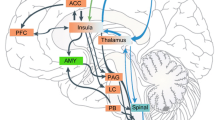Abstract.
The sensation commonly referred to as ‘pain’ has two components. The first is the sensory-discriminative component and provides information on location, modality and intensity of stimuli. The second is the affective-motivational component and refers to the emotional responses (fear, distress etc.) and the urge to respond evoked by the somatic sensation, and at the cortical level these two components appear to be located in different regions. The cortex probably influences pain by two different mechanisms. There is good evidence that the cortex can reduce pain by interrupting the transmission of noxious information from the spinal cord level by activating descending pain modulatory systems located in the brainstem. Less well established is the idea that modulation can also occur at the cortical level to change the affective-motivational aspects of nociception so that pain is perceived but looses its emotional and aversive component.
Similar content being viewed by others
Author information
Authors and Affiliations
Corresponding author
Additional information
Received 28 June 2004; received after revision 17 August 2004; accepted 21 August 2004
Rights and permissions
About this article
Cite this article
Ohara, P.T., Vit, J.P. & Jasmin, L. Cortical modulation of pain. CMLS, Cell. Mol. Life Sci. 62, 44–52 (2005). https://doi.org/10.1007/s00018-004-4283-9
Issue Date:
DOI: https://doi.org/10.1007/s00018-004-4283-9




